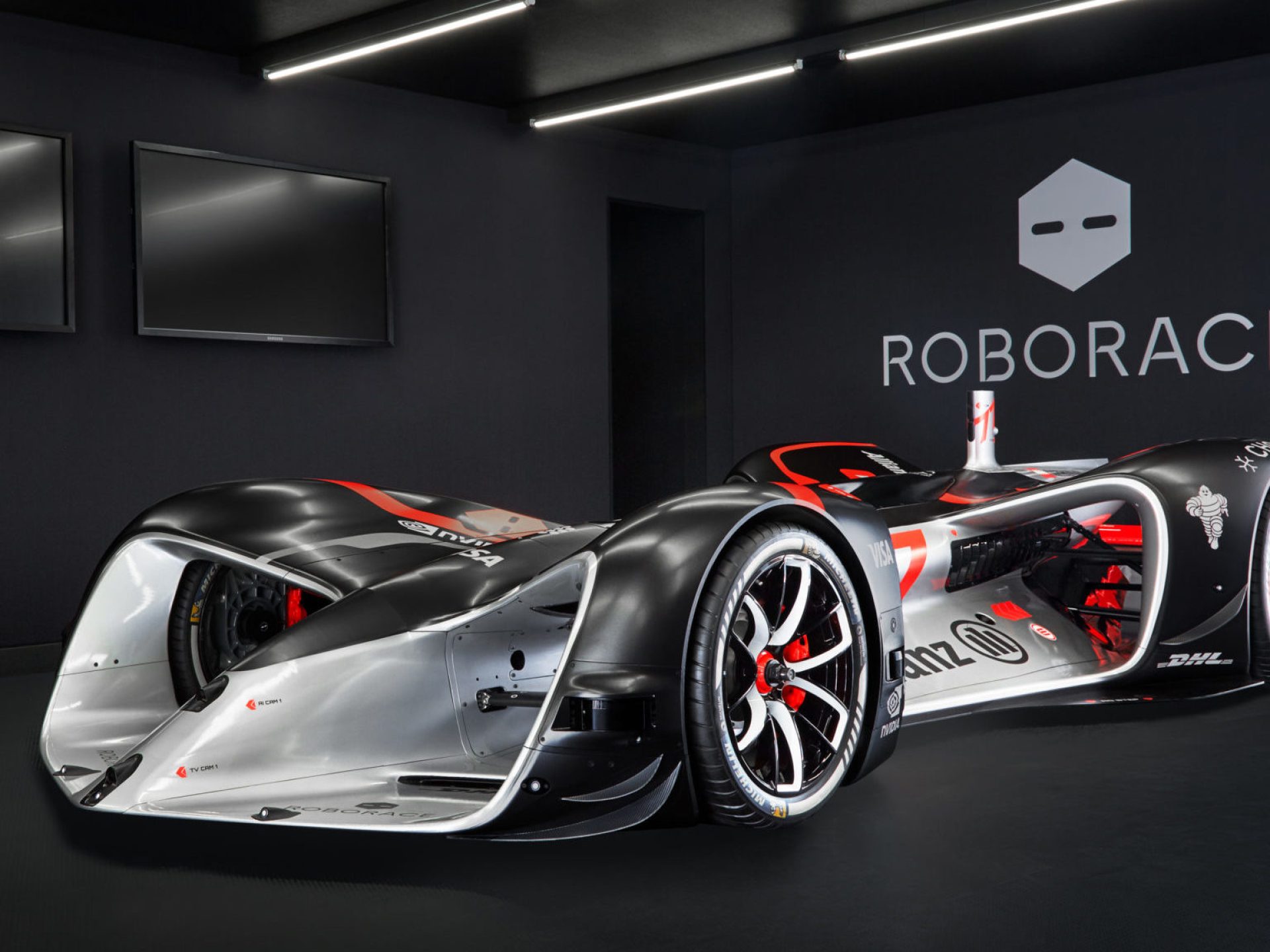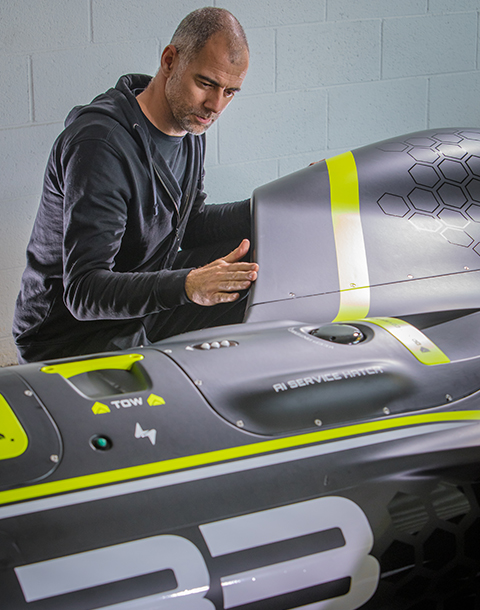Magazine

October 23, 2019

This article was originally published in Populous Magazine, our biannual publication featuring news, information, and trends from the worlds of sport, entertainment, and major public events. Find out more, and sign up to receive a free copy, here.
Racing cars controlled by artificial intelligence, and no human drivers to be seen. This isn’t sci-fi but a real-life motor racing competition. Dominic Bliss meets the design brains behind it.
Vehicle designer Daniel Simon believes the next generation of motor racing won’t have human drivers behind the wheel. Instead it will see artificially intelligent computers controlling the cars.
He should know. After all, he is chief design officer for a new motor racing competition called Roborace, featuring self-driving electric cars controlled entirely by computer software. Yes, human beings programme the computers, but other than that, the cars race entirely autonomously. The sport is still very much in its test phase, with more than a few technical problems to be ironed out. But races have already been staged at the Circuito Monteblancoin Spain and the Autodromo di Modena in Italy, with two teams competing – Technical University of Munich and an electric vehicle manufacturer called Arrival. According to Simon, the top speed achieved so far is “something close to 180mph, 190mph”. A record for the world’s fastest electric vehicle might soon be in the offing.
Once programmed, the AI computer inside the Roborace cars controls the steering, the brakes, the accelerator, the race line, the gear selection, the speed – using onboard radars, 3Dlaser scanners and cameras to negotiate its way around the racetrack, all under the power of an electric engine. Like all AI, the more the computer practises, the more it learns and solves any problems, quickly improving its racing skills.
“These cars are so incomprehensibly powerful in their learning capacity,” Simon explains. “Right now it’s like having a two-year-old Lewis Hamilton in a monstrously powerful racing car. The speed at which they are developing is extraordinary.”
But with human drivers removed from the equation, can motor sport fans truly engage with the sport? Will they ever cheer on driverless cars in the same way they cheer on Hamilton, Vettel, Bottas et al?

Simon insists they will… once they get used to the idea. “Autonomous vehicles are coming. The rise of AI is inevitable. And racing is nothing other than a competition to find out who is the best.”
He points to an old adage that suggests motor racing was invented as soon as two motor cars had been built. “In the same way, as soon as there are two AI cars, there has to be AI racing to find out which one is faster,” he adds.
Right now it’s the humans who are searching for the answer to this question. But Simon suggests a time might come when the AI computers themselves want to find out who’s the fastest. “At this point, that’s a philosophical question,” he concedes.
Not that autonomous motor racing couldn’t borrow the more exciting elements of its human-driven equivalent. Perhaps, as Simon suggests, Roborace cars might be temporarily suspended if they crash, just as human drivers have to physically recover after accidents. Or if the crash is especially dramatic, perhaps the car could be permanently eliminated from the competition, just as a human driver might die in a serious accident.
Simon has a refreshingly vivid imagination. “I question so many established ideas of our world by trying to look at them as an alien who has just landed upon our planet would,” he says. You can see his imagination at work in some of the futuristic sci-fi vehicles he has designed for Hollywood movies: the cars and motorbikes in Tron: Legacy, for example; or Tom Cruise’s Bubbleship helicopter in Oblivion; or the 1940s-style cars, motorbikes, aircraft, submarines and tanks in Captain America: The First Avenger.
Having also worked on real-life vehicles for the likes of Volkswagen, Bugatti, Lotus, Bentley, Skoda, Lamborghini and Seat, Simon finds the freedom and variety of fictitious vehicles liberating. “In filmmaking you can design a vehicle specifically to fit into a story rather than to fit a specific engine,” he says.
Now 44 years old, he has been drawing vehicles of one shape or another since he was a toddler. Growing up in the East German city of worked as an engineer at the city’s shipyard.
It’s like having a two-year-old Lewis Hamilton in a monstrously powerful racing car. The speed at which Roborace cars are developing is extraordinary.
“I drew mostly ships and trains because my father was into those, but cars came into the mix quite quickly,” he remembers. In his teenage years, when he realised vehicle design could be a profession, he graduated to “photo-realistic paintings of unimaginably beautiful vehicles”.
Although the Berlin Wall fell when Simon was 14 years old, he suspects his early life under a communist government has had a certain influence on his design style.
“I didn’t grow up with mass consumerism where I could have a new toy every day,” he explains. “I cherished my amazing toys for a few years instead of expecting a new one just around the corner.”
This, he feels, imbued him with an appreciation for timeless design and product longevity. “When it comes to car styling, I’m not a fan of high fashion designs that look good for just a few months but then, a year later, look really dated.”
Following the German reunification in 1990, Simon took a degree in automotive design before working for Volkswagen. His big break came thanks to the 2010 film Tron: Legacy. Nowadays he lives with his wife and child in Los Angeles.
The artificially intelligent computer controls the steering, the brakes, the accelerator, the race line, the gear selection, the speed – using onboard radars, 3D laser scanners and cameras.
What about his own choice in motor cars? Parked in his garage are a Volvo XC60 and a 2006 Ford GT which he describes respectively as “a ridiculously practical car and a ridiculously impractical car”. The car designs he loves most are “the voluptuous and elegant shapes of the 1960s endurance sports cars”: models such as the Ford P68, the Ferrari 312 P and P4, and the Porsche 910 and 917.
In the correct light, and if you squint a little, you might spot curves from these classic racing cars in Simon’s Roborace car designs. Although the latter, with their gaping front and rear wings, ultra-low profile, extended floor and onboard radar, don’t resemble anything you’d ever find on our city roads.
But that’s the point. Just as technology forged in Formula 1 eventually ends up in production vehicles, so Roborace is a high-end test bed for technology that will one day filter down to the everyday autonomous cars that will soon be gracing our roads.
Simon points out how our society’s entire relationship with vehicles will need to change in the future. “Right now, each of our houses has 1.5 tonnes of metal, rubber and animal skin parked outside,” he says of our city streets. “Most of the time these cars are just sitting there, doing nothing, taking up space. This makes no sense. If autonomous cars can create a transport system that is on demand, where households share a few vehicles, for example, wouldn’t that be fantastic?”
Who knows? Perhaps Roborace could accelerate the development of self-driving cars on our roads. As Simon concludes: “The happiness they could create would be staggering.”
Lorem ipsum dolor sit amet consectetur, adipisicing elit. Non facere corporis et expedita sit nam amet aut necessitatibus at dolore enim quis impedit eius libero, harum tempore laboriosam dolor cumque.
Lorem, ipsum dolor sit amet consectetur adipisicing elit. Illo temporibus vero veritatis eveniet, placeat dolorem sunt at provident tenetur omnis, dicta exercitationem. Expedita quod aspernatur molestias eum? Totam, incidunt quos.